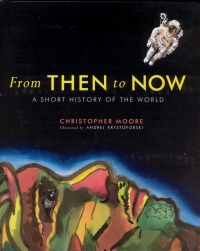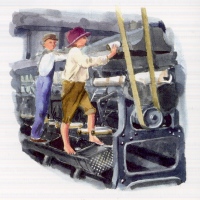| ________________
CM . . . . Volume XVII Number 39. . . .June 10, 2011. 
 |
From Then to Now: A Short History of the World.
Christopher Moore. Illustrated by Andrej Krystoforski.
Toronto, ON: Tundra Books, 2011.
188 pp., hardcover, $27.99.
ISBN 978-0-88776-540-7.
Subject Headings:
World history-Juvenile literature.
Civilization-History-Juvenile literature.
Grades 5-10 / Ages 10-15.
Review by Val Ken Lem.
***½/4
|
| |
|

excerpt:
Hunter-gatherers live lightly upon the land but they need a lot of space in which to hunt and forage (gather food). Later farming peoples sometimes imagined that their ancestors who hunted were simply homeless wanderers. Really, hunters and gatherers thrived by knowing every detail of the landscape in which they lived: where flints and obsidian (glass from volcanoes) for tools could be found, what regions were most fertile in summer and which offered shelter in winter, where animals could be found at each season of the year, exactly when each kind of plant and root and seed came into ripeness, when and where fish migrated up the rivers to spawn.
In this ambitious work, Moore, an award-winning writer of history for both adults and children, sets out to tell the story of humanity, beginning with the emergence of the species Homo sapiens about fifty thousand years ago. In general, Moore does a marvellous job in telling the story of civilization in diverse parts of the world. Due to the constraints of such an encompassing work, it is not surprising that some developments receive what seems like cursory coverage. For example, chapter ten, “The Stormy Twentieth Century,” occupies about twenty-six pages and has subheadings for: Comrade Stalin, The rise of the Fuehrer, The Great Depression, World War Two, The Holocaust and the Bomb, East against West, Turning colonies into nations, Black and white (civil rights in the USA and South Africa), Good rocking tonight (exploring social change with the baby boom, the birth of rock and roll, and the rise of feminism). The end of the Cold War, Saving the planet, and, A view from afar (space exploration). Sidebars in this chapter briefly highlight Catherine the Great (providing background for Russian history leading to the revolution and rise of communism), Golda Meir, Indira Gandhi, Radio and television, and The internet. Readers may quibble with what is highlighted in the sidebars, but overall the bulk of the text recalls numerous landmarks in human history. Occasionally Moore’s choice of prose is somewhat unfortunate, such as his description of Abraham Lincoln as a “tall, homely man” and his description of World War II extending to jungles, deserts and “arctic wastes.”
 The volume is organized chiefly in a chronological format beginning with the anthropological evidence on the origins of Homo sapiens and the spread of hunter gathering societies around the globe. The development of agriculture allowed for permanent settlements and rapid increases in population. Examples are drawn from the Middle East, China, the Americas and Africa. Likewise, global examples illustrate the rise of the Golden Empires (5000 BCE-1000 BCE) in China, Sumeria, Egypt, Central America and southern Mexico (the Mayas), east Africa (Mwene Mutapa or Great Zimbabwe) and Cambodia’s Khmer Empire and Angkor Wat. The volume is organized chiefly in a chronological format beginning with the anthropological evidence on the origins of Homo sapiens and the spread of hunter gathering societies around the globe. The development of agriculture allowed for permanent settlements and rapid increases in population. Examples are drawn from the Middle East, China, the Americas and Africa. Likewise, global examples illustrate the rise of the Golden Empires (5000 BCE-1000 BCE) in China, Sumeria, Egypt, Central America and southern Mexico (the Mayas), east Africa (Mwene Mutapa or Great Zimbabwe) and Cambodia’s Khmer Empire and Angkor Wat.
The rise of major religions and philosophies of life are tidily dealt with in ten pages. Other chapters cover the rise of Greek and Roman civilization, early European history, the era of exploration and colonization (including the scourge of slavery, Protestant reformation, and French revolution), the Age of industry (including urbanization), and Europe and America’s rise to dominance in world affairs in the 19th and early 20th centuries (including coverage of the British Empire with its jewel India and humiliation of China, the rise of Japan as a power, the American Civil War and expansionism, and The Great War). Canadian readers can take pride in the epilogue that highlights Toronto and Canada as a city and country welcoming people from all parts of the world into a multicultural milieu that represents the remixing of peoples that evolved in disparate parts of the globe in the course of human history.
Each chapter begins with a one-and-one-third page colourful watercolour illustration that is accompanied by a descriptive caption. Several additional small illustrations are scattered throughout the chapters but normally do not have captions. Usually, the person or scene depicted is evident based upon nearby text, but occasionally a proper caption would be useful. For example, the portrait of Lincoln may be erroneously identified by readers as that of General Lee who is featured in the text before and after the image.
The end papers contain a map of the world that identifies 30 significant sites discussed in the book. These are found in all continents except for Australia and Antarctica. Australia is mentioned in the book and is listed in the serviceable index. Some terms are missing from the index including energy, oil, and global warming, but some of these actually appear as subentries, as in the case of “oil and gas as fuel for” under Industrialization. Curiously, Moore does not include a selected bibliography nor list of suggested readings or websites.
Highly Recommended.
Val Ken Lem is a librarian at Ryerson University in Toronto, ON, with liaison duties for History, English and Caribbean Studies.

To comment on this title or this review, send mail to
cm@umanitoba.ca.
Copyright © the Manitoba Library Association. Reproduction for personal use is permitted only if this copyright notice is maintained. Any other reproduction is prohibited without permission.
NEXT REVIEW |
TABLE OF CONTENTS FOR THIS ISSUE- June 10, 2011.
AUTHORS |
TITLES |
MEDIA REVIEWS |
PROFILES |
BACK ISSUES |
SEARCH |
CMARCHIVE |
HOME |

 The volume is organized chiefly in a chronological format beginning with the anthropological evidence on the origins of Homo sapiens and the spread of hunter gathering societies around the globe. The development of agriculture allowed for permanent settlements and rapid increases in population. Examples are drawn from the Middle East, China, the Americas and Africa. Likewise, global examples illustrate the rise of the Golden Empires (5000 BCE-1000 BCE) in China, Sumeria, Egypt, Central America and southern Mexico (the Mayas), east Africa (Mwene Mutapa or Great Zimbabwe) and Cambodia’s Khmer Empire and Angkor Wat.
The volume is organized chiefly in a chronological format beginning with the anthropological evidence on the origins of Homo sapiens and the spread of hunter gathering societies around the globe. The development of agriculture allowed for permanent settlements and rapid increases in population. Examples are drawn from the Middle East, China, the Americas and Africa. Likewise, global examples illustrate the rise of the Golden Empires (5000 BCE-1000 BCE) in China, Sumeria, Egypt, Central America and southern Mexico (the Mayas), east Africa (Mwene Mutapa or Great Zimbabwe) and Cambodia’s Khmer Empire and Angkor Wat.